Growing and caring for walnuts in the garden, taking into account the climate
In order to avoid disappointment and harm your garden, it is important to know how to plant a walnut correctly. This tree is a long-liver, so you need to think about whether there is a suitable place for it on the site, take into account all the nuances in its development. A careful approach to this issue is the key to an excellent harvest in a few years.
Walnut features
Walnut is a tall tree. If properly cared for in the garden, it can stretch up to 20 meters in height. Its crown is spreading, up to 15 meters in diameter, branches diverge from the trunk at right angles.
The root system of the walnut is powerful. The main root grows for the first 3 years. It is pivotal and penetrates deep into the soil. At 4-5 years of age, lateral roots begin to develop, which rush in all directions and diverge at a distance of 5-6 meters from the main root. They are located shallow, 30-50 cm from the soil surface. For centuries-old trees, the roots occupy a space with a diameter of about 20 meters. A developed root system allows an adult tree to easily tolerate insufficient watering and low rainfall.
If you cut a walnut and leave a stump, a lot of growth will begin to grow from it, which begins to bear fruit for 2-3 years. If you need to get rid of the old stump, you will have to uproot it. Shoots do not grow from the roots.
Flowering begins in spring, early or mid-May. Flowers and leaves bloom at the same time. Re-flowering is possible in June, most often in the southern or middle lane. On the nut, male flowers appear, collected in earrings of several pieces, and female flowers at the ends of annual shoots. They are pollinated by the wind.
Nuts are ready to be harvested in September or October; fruits from the same tree may vary in taste and size.
Propagated by seeds or grafted seedlings.
Rules for planting a walnut tree in the garden
When planning to grow a walnut tree in the garden, consider the following.
- Due to the developed root system and spreading crown, the plants should be planted at a distance of 5-6 meters from each other.
- Walnut, having reached the age of 20, takes nutrients and moisture from the soil, and its crown gives a thick shade. When choosing a place for seedlings, one must take into account that it will be impossible to grow something within a radius of 10 meters from the nut.
- You can not carry out the cultivation of walnut near the house. Its roots can destroy the foundation.
- In the process of photosynthesis, the walnut releases substances that inhibit other fruit trees. It will be correct if you leave at least 10 meters between them during landing.
- The place should be sunny, in the shade the plant stagnates and dies.
- The walnut prefers loose, drained soil.
- Does not tolerate areas with high groundwater levels, as well as flooded during floods and rains.
Advice
It is best to cultivate a walnut tree at the far end of the garden. On a spacious plot, it will be able to fully develop and will not interfere with other plants. In a small garden, planting a walnut is undesirable.
Demanding climatic conditions
Walnut is a thermophilic plant. Efficient cultivation is possible in the southern regions.
In the middle lane, the tree takes root well and bears fruit, but only if the winter temperature does not drop below -25 °. In severe frosts, the tree dies.
In the middle part of Russia, it is recommended to grow bred hybrids that can withstand temperatures down to -30 °. They differ in small growth, weaker harvest, do not bear fruit every year.
In the Leningrad Region, tree-shaped walnuts do not grow. Does not bear fruit regularly. If some of the branches freeze in winter, there will be no nuts in the fall.
Summer heat is easily tolerated by adult plants due to the developed root system. Young trees up to 5 years old need watering 2-3 times a month, more often during drought.
Seed propagation
Seed cultivation will be successful if nuts harvested last year are used. This method has several disadvantages:
- the nut grows slowly, it can be planted in a permanent place only after 5-7 years;
- 10 years after seed germination, the first crop appears, but it is scarce;
- full fruiting begins only by 20-30 years.
If the seeds are planned to germinate in spring, then they must undergo stratification. The nuts are buried in a container with wet soil or sand and placed in a cold place where the temperature is 4-6 °. The soil and sand must be warmed up in the oven or disinfected with a weak solution of potassium permanganate.
That's right, if the nuts are sorted beforehand. Thick-walled ones are sent for stratification 3 months before planting, and those with thin shells - 2 months before. Seed care during stratification consists in keeping the sand moist and controlling the temperature.
Important!
It is recommended to take seeds from trees growing in the same area where you plan to plant a new plant. If this is not possible, then you should buy them from trusted sellers. Only high quality last year's nuts have good germination.
They are planted in the ground in April. It is important that the soil is heated to 10 °. The garden must be prepared in advance.
Planting depth - from 5 to 8 cm, depending on the size of the seeds. The distance between the nuts is 30 cm. Correctly place the nut sideways, longitudinal groove down. They hatch quickly, within 5-10 days. Seedlings grow vigorously at first, but when they reach 15 cm, growth slows down. The stem begins to form.
You can accelerate the growth of seedlings if the seeds are sown in a greenhouse. The preparation period for seedlings is reduced by three times.
Care for seedlings both in the open field and in the greenhouse is simple: watering, weeding, loosening. Mulching can be made easier to care for; it reduces the frequency of watering and prevents weeds from growing.
Graft
To speed up the fruiting of trees grown from nuts, you can use grafting. To carry out this procedure correctly, you must wait until the age of the seedlings (stock) reaches 2 or 3 years.
The best time for vaccination is February, when sap flow has not yet begun. The graft should be taken from the nursery in your region, from the mother plant, adapted to the climate. Inoculated in the cleft.
The grafted seedlings can be planted in a permanent place in the second year after grafting.
Planting seedlings
The time of planting a seedling in a permanent place depends on the region.
In the southern lane, the best period is autumn. The nut will have time to take root before winter, without wasting energy on building up green mass. In autumn, care for him is minimal - there is no sweltering heat, the soil is moistened, weeding and loosening are not required.
If a nut is planted in the south in the spring, it will not have time to get stronger and will die from the summer heat. To preserve such a seedling in the summer, a lot of effort will have to be spent on additional care, which consists in constant watering with warm water.
In the middle lane, seedlings are planted only in the spring, so that by autumn they will take root and get stronger.
The pits should be 50x50 cm in size, the same depth. Fill them with fertile soil, add humus and wood ash.
A peg is driven into the center of the pit for support. In the first three years, the central taproot develops, and there are very few lateral ones that support the tree in the soil. An unsupported seedling can be damaged by wind.
The plant is deepened into the soil so that the root collar is at ground level.
Further care
Good care is needed in the first three years after landing in a permanent place.Top dressing is carried out twice: in the fall, phosphorus and potash fertilizers are applied, and in the spring, nitrogen is needed to build up the aboveground part. The soil should be moist, but not wet. The soil should dry out slightly between waterings.
When the tree reaches the age when fruiting occurs, nitrogen fertilizers are reduced or applied every three years. Watered only during dry periods.
When pruning remove branches bent down, crossed or directed inward.
Walnuts are almost not susceptible to diseases and pests.
Output
The walnut is an easy-to-care tree that needs little attention after reaching 4-5 years of age.
You can speed up the harvest by planting seedlings bought in a nursery or grafted on your own. To get fruit from a tree grown from seeds, you have to be patient and wait at least 10 years.
The walnut is a big garden favorite that looks beautiful as a single plant. In a small garden, he will also grow, but he will destroy all the trees and shrubs growing next to him.


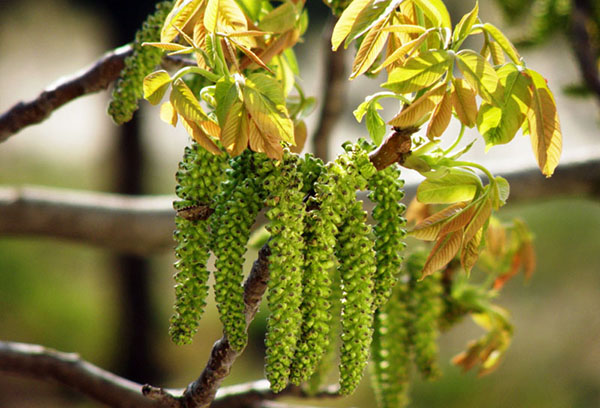
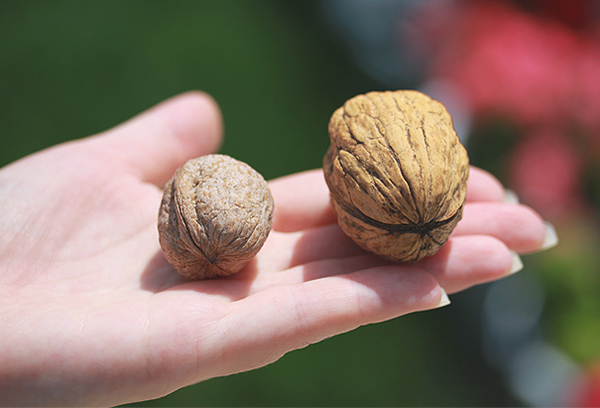
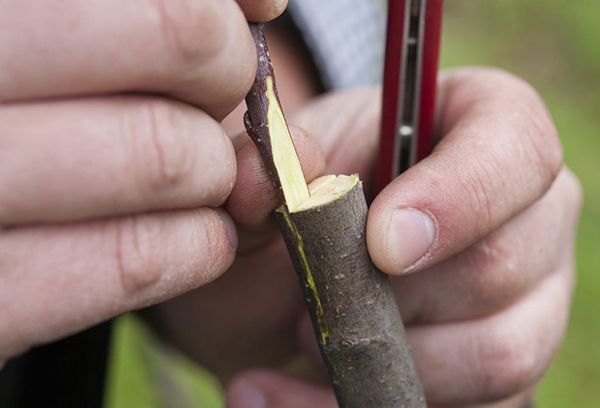

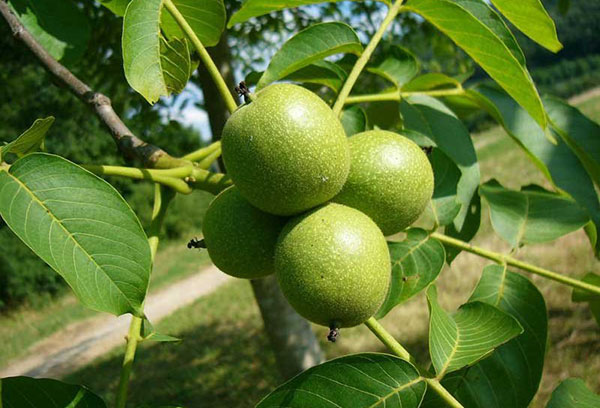
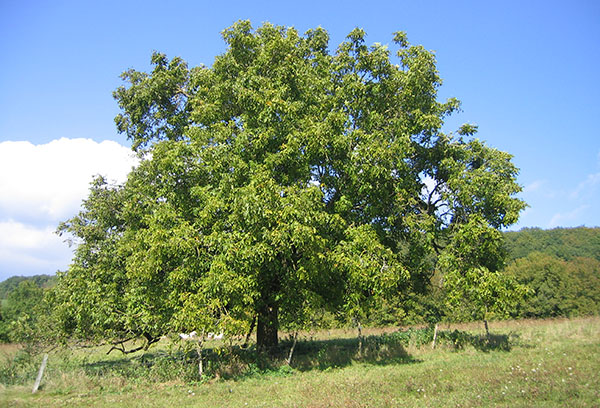
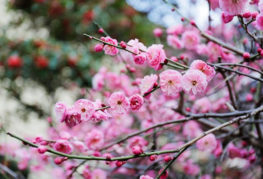
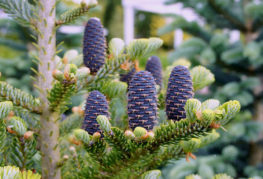
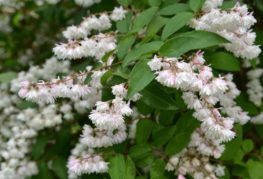



and will be published shortly.